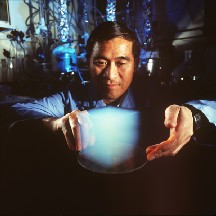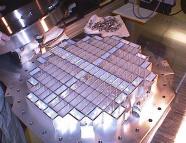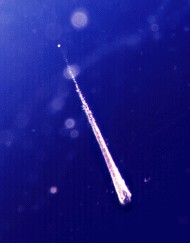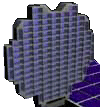|
|
Aerogel - A Little Bit of Almost Nothing
|
|
Catching comet dust is no easy feat! When the spacecraft flies
past the comet, the impact velocity of the particles they are captured will
be up to 9 times the speed of a bullet fired from a rifle. Although the
captured particles will each be smaller than a grain of sand, high-speed
capture could alter their shape and chemical composition - or vaporize them
entirely.
|

Dr. Peter Tsou with a sample of Aerogel.
|
To collect the particles without damaging them, STARDUST will
use an extraordinary substance called aerogel - a silicon-based solid with a
porous, sponge-like structure in which 99 percent of the volume is empty
space. Aerogel is 1,000 times less dense than glass, another silicon-based
solid. When a particle hits the aerogel, it will bury itself in the
material, creating a carrot-shaped track up to 200 times its own length, as
it slows down and comes to a stop - like an airplane setting down on a runway
and braking to reduce its speed gradually. Since aerogel is mostly
transparent - sometimes called blue smoke - scientists will use these tracks
to find the tiny particles.
|
Aerogel Facts...
- 99.8% Air
- 39 times more insulating than the best fiberglass insulation
- 1,000 times less dense than glass
- Used on Mars Pathfinder's rover
|

Photograph courtesy of
Ernest Orlando, Lawrence Berkeley National Laboratory
|
|
Learn more about Aerogel from our Aerogel
brochure. Available on line in pdf format:
AEROGEL BROCHURE
|
Collection of Dust Samples using Aerogel
The primary objective of the STARDUST mission is to capture both comet coma
samples and contemporary interstellar grains moving at high velocity with
minimal heating and other effects of physical alteration. To achieve this a
new intact capture technology has been developed over the past decade
specifically for comet flyby sample return missions [Tsou 1984] in which
hypervelocity particles are captured by impact into underdense, microporous

Aerogel Dust Collector
Under Construction
|
media known as aerogel [Tsou 1994]. This is not like conventional
foams, but is a rather special porous material that has extreme microporosity
at the micron scale. Aerogel is composed of individual features only a few
nanometers in size, linked in a highly porous dendritic-like structure.
This exotic material has many unusual properties, such as uniquely low
thermal conductivity, refractive index, and sound speed, in addition to its
exceptional ability to capture hypervelocity dust. Aerogel is made by high
temperature and pressure critical point drying of a gel composed of colloidal
silica structural units filled with solvents. Over the past several years,
aerogel has been made and flight qualified at the Jet Propulsion Laboratory.
The JPL facility will produce the aerogel for the STARDUST mission and
provide well controlled media properties and purity. For volatiles
collection each

Particle Captured in Aerogel
|
collector medium will be dopped with selected absorbents. Silica aerogel
produced at JPL is a water clear, high purity silica glass-like material that
can be made with bulk density approaching the density of air. It is strong
and easily survives launch and space environments. JPL aerogel capture
experiments have flown [Tsou 1993] and been recovered on Shuttle flights,
Spacehab II and Eureca. Examples are shown in these photos of Cometary Dust
Particles. For additional technical information about aerogel
see, Berekley
National Laboratory at http://eande.lbl.gov/ECS/aerogels/satoc.htm.)
When hypervelocity particles are captured in aerogel they produce narrow
cone-shaped tracks, that are hollow and can easily be seen in the highly
transparent aerogel by using a stereo microscope. The cone is largest at the
 |
| Dust Collector |
|---|
point of entry, and the particle is collected intact at the point of the
cone. This provides a directionality detector and is the basis of our
approach of using single slabs of aerogel to collect both cometary and
interstellar dust, and being able to differentiate between them because the A
side of the collector is exposed in the comet dust impact direction and the B
side is positioned toward the interstellar dust stream. After the encounter
with Wild 2, the aerogel collector will be retracted into the Sample Return Capsule (SRC) and
returned to Earth for detailed analysis by scientists.
|
|

